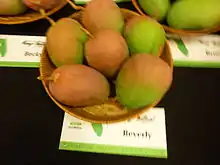Beverly (mango)
The 'Beverly' mango (or, 'Beverley') is a named mango cultivar that originated in south Florida.
| Mangifera 'Beverly' | |
|---|---|
 Beverly mangoes at the 2010 Fairchild Tropical Botanic Garden's International Mango Festival in Coral Gables, Florida | |
| Genus | Mangifera |
| Species | Mangifera indica |
| Hybrid parentage | 'Cushman' × unknown |
| Cultivar | 'Beverly' |
| Origin | Florida, USA |
History
Beverly was a reportedly a 'Haden' seedling selected by the Zill family of Boynton Beach, Florida. However, a 2005 pedigree analysis estimated that the 'Cushman' cultivar was the parent.[1]
The cultivar did not gain widespread commercial acceptance due to the fruit's lack of color at maturity. However, it did gain popularity as a dooryard cultivar due to its flavor, disease resistance, and late ripening season, and is now sold as nursery stock in Florida. Beverly was selected as a curator's choice mango by the Fairchild Tropical Botanic Garden for their 2008[2] and 2009 mango festivals.
Beverly trees are planted in the collections of the USDA's germplasm repository in Miami, Florida,[3] the University of Florida's Tropical Research and Education Center in Homestead, Florida,[4] and the Miami-Dade Fruit and Spice Park,[5] also in Homestead.
Description
The fruit is of round to oval shape, with no or minimal lateral beak. Weight can vary from a pound to 3 pounds. At maturity, the fruit remains largely green with some yellow. The flesh has no fiber, is rich in flavor, and contains a monoembryonic seed. It ripens from July to August in Florida.
The tree has a low growth spreading habit, and can be kept under 20 feet.
See also
References
- Cecile T. Olano; Raymond J. Schnell; Wilber E. Quintanilla & Richard J. Campbell (2005). "Pedigree analysis of Florida mango cultivars" (PDF) (118). Proc. Fla. State Hort. Soc: 193. Archived from the original (PDF) on 2010-06-18. Cite journal requires
|journal=(help) - "Archived copy" (PDF). Archived from the original (PDF) on 2011-06-11. Retrieved 2010-06-15.CS1 maint: archived copy as title (link)
- http://www.ars-grin.gov/cgi-bin/npgs/acc/display.pl?1089557%5B%5D USDA, ARS, National Genetic Resources Program. Germplasm Resources Information Network - (GRIN). [Online Database] National Germplasm Resources Laboratory, Beltsville, Maryland.
- http://trec.ifas.ufl.edu/crane/pdfs/TREC-Fruit-Collections.pdf Archived 2018-04-08 at the Wayback Machine Page 2, #9
- "Archived copy". Archived from the original on 2010-07-11. Retrieved 2010-11-14.CS1 maint: archived copy as title (link)